Cherry blossoms (桜, Sakura) are the most well-known Japanese flower overseas, but in Japan, plum blossoms (梅, Ume) are also extremely popular and one of the most iconic flowers in Japanese culture.
In this article, we will introduce the plum blossom season in Japan and some of the best places to see ume blossoms in Japan. Also, learn how much ume flowers mean and what they signify in Japanese culture.
Table of Contents
- Ume Flowers True Identity, What is Ume?
- When is the Plum Blossom Season in Japan?
- Characteristics of Ume Flowers
- Ume Meaning and Significance in Japanese Culture
- 8 Best Places to See Ume Flowers in Japan
Ume Flowers True Identity, What is Ume?

Ume (梅) are Japanese plum or Japanese apricot. It is a fruit-bearing tree native to China but was introduced to Japan during the Asuka period (592 to 710 A.D.) as a type of medicine called Ubai, but has become cultivated extensively in Japan. Plum tree groves are called 梅林 (Bairin), and ume blossoms are called 梅花 (Baika) in Japanese.
The fruit of the ume tree resembles a small, round plum. It is commonly used in Japanese cuisine for making preserves, condiments and alcoholic beverages. A popular ume product is umeboshi, which is pickled ume fruit. As for drinks, the alcoholic umeshu, a sweet fruit liquor, is incredibly popular.
In Japanese culture, the ume tree and its blossoms hold significant symbolism and are associated with themes of perseverance, beauty, and the arrival of spring.
Prior to the beginning of Hanami (cherry blossom viewing culture in the Nara period, the term Hanami still meant “flower viewing” and included plum blossom viewing enjoyed by aristocrats. After cherry blossom viewing took off, the activity of plum blossom viewing came to be called 梅見 (Umemi) or 観梅 (Kanume).
Writer's Pick
When is the Plum Blossom Season in Japan?
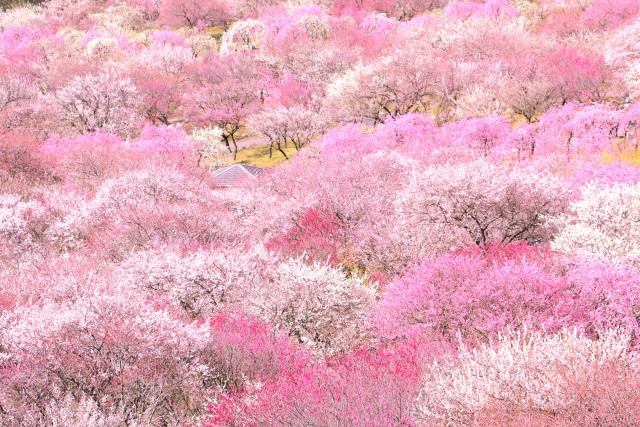
Ume flowers are the earliest blooming flowers in Japan, around late winter to early spring. Which is why they became the symbols of perseverance and arrival of spring.
The plum blossom season in Japan is typically from early February to mid-March, though warmer regions will start to bloom earlier and colder regions later. The exact timing depends on region and climate conditions. Plum blossoms start to bloom gradually from south to north Japan as the weather gradually becomes warmer. In warmer regions like Kyushu and Okinawa, plum blossoms may start blooming as early as late January. As for colder regions like Hokkaido, they may bloom later, starting in late March to April, and peak in late April to May.
Compared to cherry blossoms, plum blossoms have shallow dormancy, so their blooming start time is greatly affected by weather conditions. In years when there are high temperatures, suitable humidity levels, and lots of sunshine, plum blossoms will bloom earlier than normal.
Peak of plum blossom season in Tokyo is typical around mid-February to March.
Characteristics of Ume Flowers
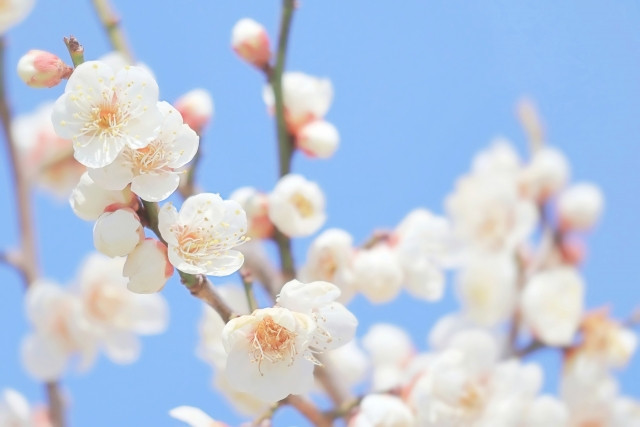
Ume can be separated into two broad categories:
- Ume trees cultivated for blossom viewing
- Ume trees cultivated for their fruit, aka agricultural purposes
Ume flowers are characterised by the roundness of their petals. There are a variety of Ume species, and so the shape of flowers can differ, and they come in a myriad of colours. Ume blossoms can come in light shades of pink to dark pink, red and also white.
Another general characteristic of plum blossoms is that they do not grow in clusters, with one ume flower to a node. Ume blossoms also tend to grow sparsely and away from each other. Keep in mind that different species may harbour different characteristics.
Language of Flowers for Plum Blossoms
In the language of flowers (花言葉, Hana Kotoba), ume flowers carry the general meaning of “nobleness”, “patience”, and “loyalty”.
Red plum blossoms (紅梅, Koubai) also carry the meaning of “elegance” and “charming”. Their meanings are derived from their bold colours and sweet fragrance.
On the other hand, white plum blossoms (白梅, Shiraume) carry the meaning of “sophistication” and “grace” due to their delicate image, and how they present a clean and neat atmosphere.
As for pink plum blossoms, they also carry the meaning of “purity” due to their light colour that gives a feeling of freshness and softness. Pink plum blossoms are common motifs for children’s Kimono.
Similar Looking Flowers to Plum Blossoms
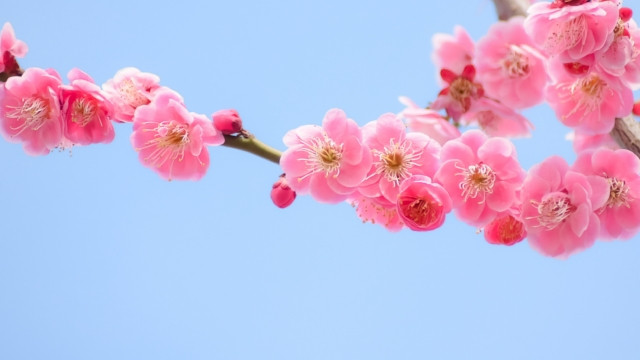
Plum, peach and cherry blossoms share similar characteristics - pink and spring flowers. Cherry blossoms and plum blossoms in particular are frequently confused as depending on their species, the timing of when they start to bloom may overlap. Trying to figure out which is which is quite a fun (and spontaneous) activity.
Read about “How to Distinguish between Plum, Peach and Cherry Blossoms” here.
Ume Meaning and Significance in Japanese Culture
Cherry blossoms (桜, Sakura) are the most well-known Japanese flower overseas, but in Japan, plum blossoms (梅, Ume) are also extremely popular and one of the most iconic flowers in Japanese culture. Below, we introduce some representations of plum blossoms and plums in Japanese culture.
Auspicious Grouping of Shou-Chiku-Bai (松竹梅)
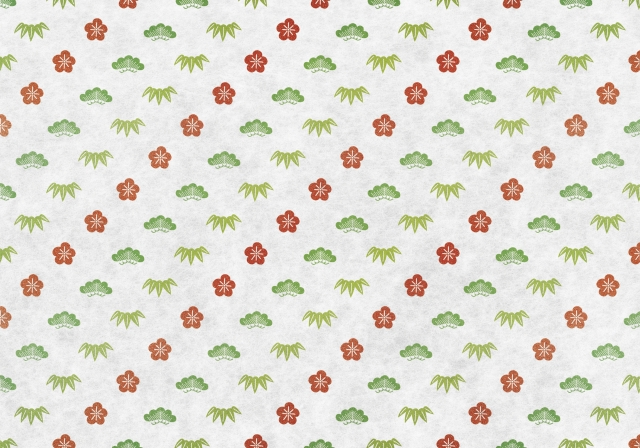
松竹梅 (Shou Chiku Bai), or “Pine, Bamboo, Plum”, is an auspicious traditional Japanese pattern that symbolises birth and strength of life.
- Pine (松, Matsu) : the pine tree is green throughout the year showing vitality of life
- Bamboo (竹, Take) : the bamboo tree roots firmly in the ground and grows strong and straight towards the sky
- Plum (梅, Ume) : the plum tree and its ume flowers bloom earlier than any other flower at the end of winter is an auspicious flower in Japan
The 松竹梅 (Pine, Bamboo, Plum) pattern is popular for making Kimono fabrics, wallpaper for traditional Japanese rooms, 和室 (Washitsu), and accessories.
Traditional Japanese Pattern with Ume Flowers
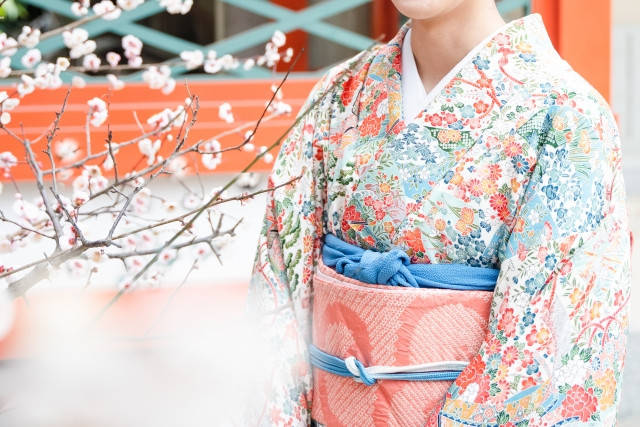
The ume flower pattern is one of the most popular traditional Japanese patterns. At traditional Japanese accessories shops and souvenir shops, you can find countless products that use the ume flower pattern. These includes Kimono, handkerchiefs, traditional Japanese paper (和紙, Washi), clothing, postcards, letter sets, fans, pottery, towels, bags, and more. Ume blooms symbolise resilience, beauty, and the arrival of spring.
The ume flower pattern is particularly popular during the Japanese New Year and other traditional Japanese annual events like Shichi-Go-San (七五三), Coming-of-Age Day (成人の日, Seijin no Hi), and Hinamatsuri (ひな祭り). Beautiful and adorable ume flower patterned Kimono, hair accessories and even ume-motif nails, are favoured by young girls and ladies.
Ume Flowers and Hanafuda

Hanafuda (花札) are Japanese playing cards used to play the traditional Japanese card game of Karuta. Hanafuda consists of 12 suits of 4 cards, each suit represents a month and each month is indicated by a flower illustration. The ume flower represents the month of February.
Ume Flowers in Japanese Poetry and Art
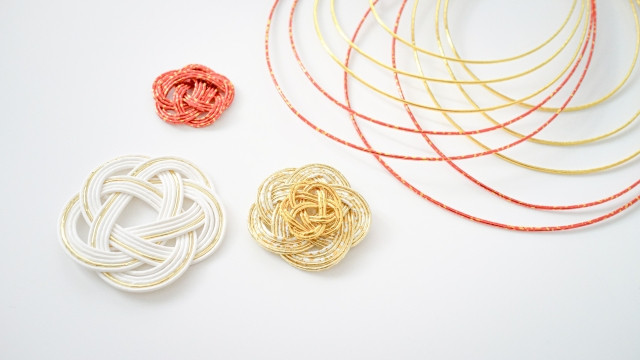
Ume flowers are also frequently depicted in Japanese poetry, especially Haiku (俳句), and also Japanese art and paintings. Ume flowers are often used to symbolise the coming of spring and representation of the beauty of nature.
Here is an example of a famous Haiku that features plum blossoms:
梅が香に 昔の一字 あはれなり
ume ga ka ni mukashi no ichiji aware nari
The fragrant plum, the days of old, it’s a pity that nothing lasts- by Matsuo Basho (松尾芭蕉)
Ume in Japanese Cuisine
Ume trees are Japanese plum trees that produce plum fruits called 梅 (Ume) in Japanese. Ume fruits are used to make drinks and also to flavour food. Here are some examples of ume in Japanese cuisine.
Umeboshi (梅干し)
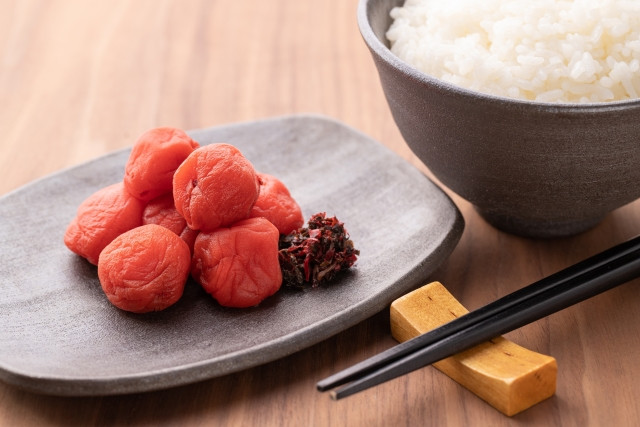
Umeboshi is pickled dried plum. Salty or sweet Umeboshi are available, but the most common type is sour. Umeboshi is a healthy snack, good for relieving fatigue and improves digestion. The sourness also improves one's appetite.
Umeboshi Onigiri is one of the most classic and basic Japanese rice ball (おにぎり, Onigiri) flavours. A whole Umeboshi is usually pressed into the back of a triangle-shaped Onigiri.
Additionally, Umeboshi are also common side dishes to traditional Japanese set meals. They are also common as a rice topper for Ekiben and Bentos as Umeboshi contain antibacterial properties that reduces the risk of food spoiling.
Hinomaru Bento (日の丸弁当) is a simple traditional Bento consisting of rice and a single Umeboshi in the centre. It is called Hinomaru Bento, as its appearance resembles the Japanese flag, called Hinomaru.
梅酒 (Umeshu)
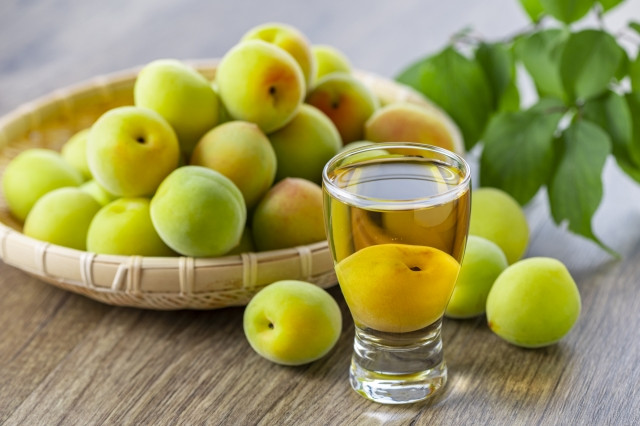
Umeshu is Japanese plum wine, a fruit liqueur (果実酒. Kajitsushu) a type of Japanese alcoholic drink. Other types of Kajitsushu include Mikanshu, Yuzushu, etc. but Umeshu is the most famous.
Summer, particularly the rainy season called Tsuyu (梅雨) (If you notice, even the Kanji for Tsuyu contains the Kanji for Ume (梅).) , is also the season for ume and therefore perfect for making umeshu. During this season, supermarkets sell homemade umeshu kits and fresh Japanese plums. Additionally, June 11th is Umeshu Day (梅酒の日, Umeshu no HI) in Japan.
You can drink umeshu at Izakayas or can buy umeshu at supermarkets, convenience stores and liquor shops in Japan.
※ The legal age to buy / drink alcohol in Japan is 20 years and above.
8 Best Places to See Ume Flowers in Japan
Want to admire the beauty of ume flowers and witness the arrival of spring? Since ume is heavily cultivated in Japan, many of the best places to see ume blossoms are ume farms that are open to visitors during the plum blossom season.
Here we introduce some of the best and most famous plum blossom spots in Japan.
Cherry blossoms (桜, Sakura) are the most well-known Japanese flower overseas, but in Japan, plum blossoms (梅, Ume) are...
Posted by WeXpats on Wednesday, February 14, 2024
1. [Ibaraki] Kairakuen
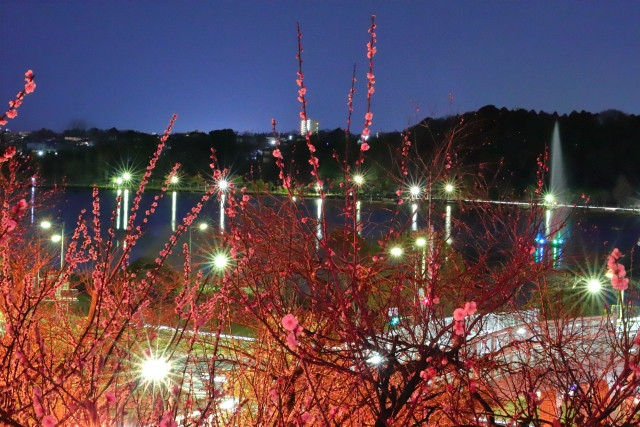
Best Time to Visit: late January to early April
Kairakuen (偕楽園) in Mito City, Ibaraki Prefecture has over 3,000 plum blossom trees. Not only is Kairakuen one of Kanto’s Three Greatest Plum Groves (関東三大梅林), it is also one of Japan’s Three Great Gardens (日本三名園) alongside Kenrokuen (Kanazawa) and Korakuen (Okayama).
Every year during plum blossom season, the Mito Plum Blossom Festival (水戸の梅まつり) is held here, typically from mid-February to late March. Kairakuen is
2. [Saitama] Ogose Plum Grove
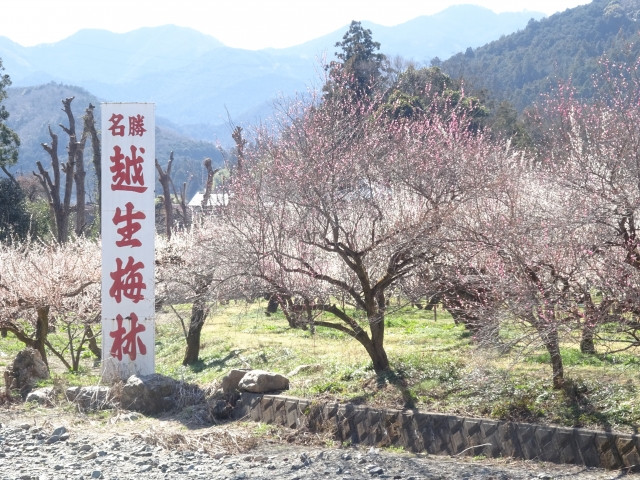
Best Time to Visit: late February to early March
Ogose Plum Grove (越生梅林, Ogose Bairin) in Iruma District, Saitama Prefecture is one of Kanto’s Three Greatest Plum Groves (関東三大梅林). There are over 20 thousand plum trees in Ogose Plum Grove including the famous 670 years old Kaisetsu (魁雪) tree.
Located along a riverside, the thousands of ume flowers in full bloom is a spectacular sight to behold. An annual plum blossom festival with food stalls and celebrations adds to the experience.
3. [Gunma] Akima Plum Grove
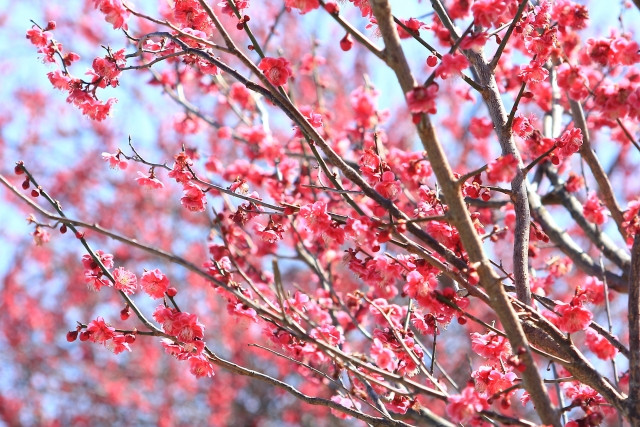
Best Time to Visit: early to late March
Akima Plum Grove (秋間梅林, Akima Bairin) in Annaka City, Gunma Prefecture is a hillside area with over 35 thousand ume trees. Akima Plum Grove, Haruna Plum Grove (榛名梅林, Haruna Bairin) and Misato Plum Grove are collectively known as Gunma’s Three Great Plum Groves (ぐんま三大梅林).
From the top of the hill, you can enjoy a panoramic view of Mount Myogi, Mount Asama, and the flowing Akima River.
4. [Tokyo] Yushima Shrine

Best Time to Visit: early February to early march
Yushima Shrine (湯島天満宮, Yushima Tenmanguu) in Bunkyo Ward, Tokyo Metropolis is one of the most popular ume flower spots in Tokyo. The shrine worships the God of Learning, Tenjin Sugawara no Michizane, which is why it is also known as Yushima Tenjin (湯島天神).
You can enjoy the view of plum blossoms with the tranquil atmosphere of a shrine. The annual Bunkyo Plum Festival is held here in early February to March. April is the start of a new school year for many Japanese and international students, so why not go plum blossom viewing and pray for academic achievement.
5. [Kanagawa] Soga Plum Grove
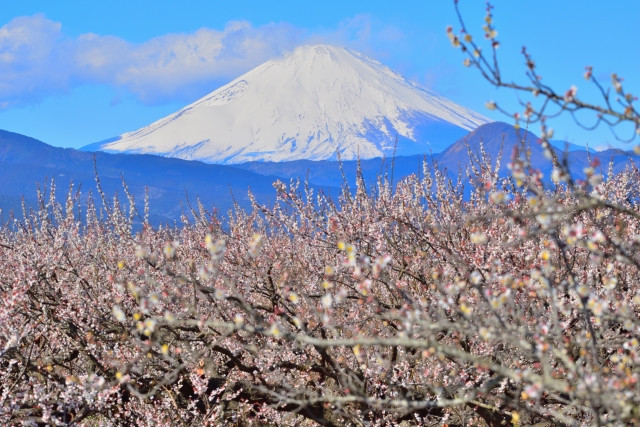
Best Time to Visit: early February to early March
Soga Plum Grove (曽我梅林, Soga Bairin) in Odawara City, Kanagawa Prefecture has fields of approximately 35 thousand plum trees. The Soga Plum Grove is part of a main facility called Soga Village (曾我の里, Soga no Sato). Similar to Ogose Plum Grove, Soga Plum Grove is also an Ume (fruit) cultivation farm that is operated by farmers.
Soga Plum Grove is one of Kanto’s Three Greatest Plum Groves (関東三大梅林). It is the main attraction of the city’s Odawara Plum Blossom Festival (小田原梅まつり) that also covers the Odawara Castle Park area. From Soga Plum Grove, you can get a clear view of Mount Fuji with plum blossoms!
6. [Shizuoka] Atami Plum Garden

Best Time to Visit: mid-January to late March
Atami Plum Garden (熱海梅園, Atami Baien) in Atami City, Shizuoka Prefecture is a peaceful garden surrounded by hills. An annual plum festival is held around mid January to early March here.
Atami City is famous as a seaside hot spring town that is easily accessible from Tokyo by Shinkansen bullet train. Not only can you admire the beauty of ume flowers, take the opportunity to enjoy the hot springs with a beachview. It can be a day trip or a relaxing overnight stay.
7. [Mie] Inabe City Agricultural Park
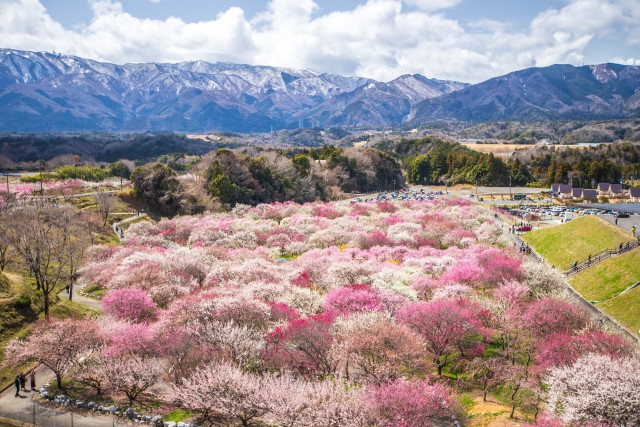
Best Time to Visit: early to mid March
Inabe City Agricultural Park (いなべ市梅林公園, Inabeshi Bairin Koen) in Inabe City, Mie Prefecture is a public park filled with thousands of plum trees, and has a golf area. It is known as one of the biggest ume flower viewing spots in the Tokai area. An annual plum blossom festival is held here in March.
From here, you can enjoy an amazing view of plum blossoms with the Suzuka Mountain Range as a backdrop. An observation spot overlooking the entire park is available so you can admire the thousands of plum trees in full bloom below you.
8. [Nara] Tsukigase Plum Grove
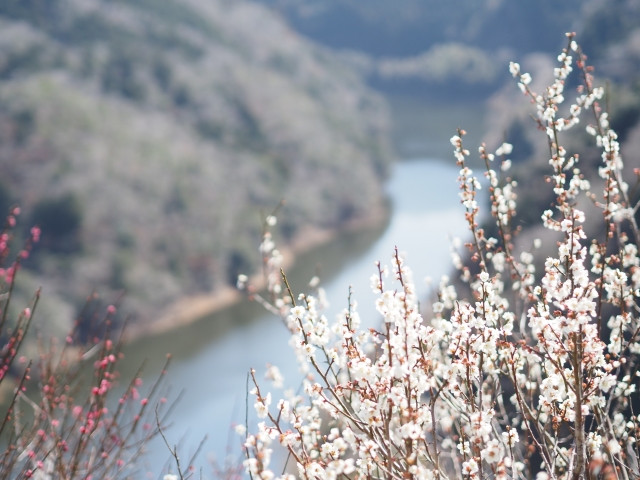
Best Time to Visit: mid-February to late March
Tsukigase Plum Grove (月ヶ瀬梅林, Tsukigase Bairin) in Nara City, Nara Prefecture is the first plum blossom viewing spot designated by the Japanese government as Nara’s Three Great Plum Groves (奈良三大梅林) - the others are Anou Plum Grove (Gojo) and Hirohashi Plum Valley (Shimoichi). There are over 10 thousand plum trees at Tsukigase Plum Grove, many of them growing along the slopes of a deep valley where the Nabari River flows.
It is said that many artists and literary figures, including Japanese Haiku poet Matsuo Basho and Japanese painter Tomioka Tessai, visited and received inspiration from the beautiful scenery.
To Close
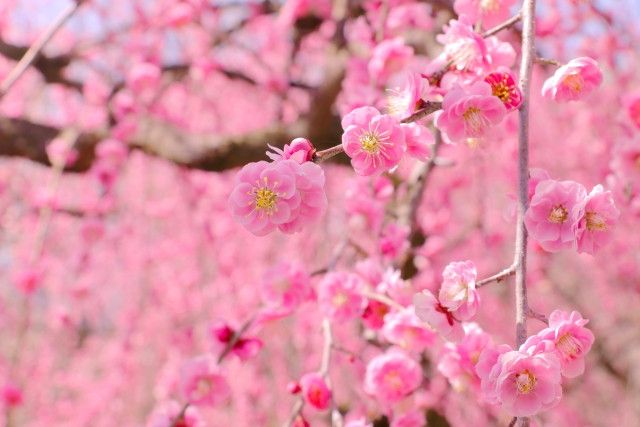
Ume flowers announce the arrival of spring in Japan. One of the most iconic flowers in Japanese culture, ume flower motifs can be found in all aspects of life. A versatile and important plant, ume are also a huge part of Japanese agriculture and food culture.

.jpg)














.jpg)



















